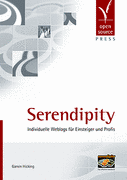I've just learned about SPARQLBot via this posting by Manu Sporny to the uf-discuss mailing list. He writes
This has to be the coolest semantic web related thing I've seen this year. Sparqlbot lets you load semantic data from various URLs and perform SPARQL queries on them via IRC using natural language. [...] The end result is something that resembles the ship computer from Star Trek.
and goes on to cite what probably was his first conversation with SPARQLbot. Funny and playful, but also a very interesting example of what is already possible with semantic web parsers.
SPARQL is a protocol and a query language for RDF data with a syntax similar to other well-known query languages. You can use it for fetching and even writing data that is stored in RDF format. SPARQLBot is a fun project that was demonstrated at Semantic Camp in London earlier this month and has been described as the Semantic Web Command Line. People can contribute their own SPARQL queries as SPARQLBot commands, and so far the count exceeds 30 entries. If you want to talk to SPARQLBot, visit #sparqlbot and give it some commands. Hilarious!
Seit längerem lese ich regelmäßig die aus der Ubuntu-Community (und Fedora?) hervorgegangene PDF-"Zeitschrift" freies magazin. Die Inhalte kreisen um die beiden genannten Distributionen, wobei auch allgemein an Linux Interessierte auf ihre Kosten kommen. Immer wieder gibt es Artikelserien, die tiefer in die Materie eintauchen, etwa über Audiotools oder andere nützliche Programme, die man üblicherweise - zumindest als Webentwickler - nicht so auf dem Radar hat. Ein sehr empfehlenswertes Magazin, das vollständig von freiwilligen Autoren quasi ehrenamtlich erstellt wird.
Möglicherweise hat sich das Yalm-Magazin daran orientiert, das vor einigen Tagen mit seiner fünften Ausgabe erschienen ist. Themen sind auch hier nützliche und interessante Linux-Programme, etwa das geniale YaKuake. Ausführlich werden auch die beiden Brennprogramme K3B und Brasero verglichen. Auch das Yalm-Magagzin gibt es kostenlos als PDF-Download und wird auf freiwilliger Basis geschrieben.
Für beide Magazine gilt: Auch wenn einem als erfahrenem Linux-Nutzer vieles bereits bekannt ist, finden sich immer wieder Perlen, die aufmerken lassen. Für Einsteiger sind beide Magazine sowieso vorbehaltlos zu empfehlen.
I'm currently overhauling this blog installation, especially some plugins that are in need of updating. This might break things temporarily, and I'm really sorry for that. However, if you can indeed read this entry, everything is working fine, so never mind  I'll post an update when I'm done and elaborate on the changes in the background. Stay tuned.
I'll post an update when I'm done and elaborate on the changes in the background. Stay tuned.
Update: I straightened things up a little, introduced two new categories, English Articles and Deutsch Beiträge (German Articles), because I might blog a little more in German from now on, and broke the download manager in the course (it's up and running again, yet I still have to re-up most of the files). All in all it could've been worse so far. Again: Stay tuned.

Good news for all (German) Serendipity users! You can now preorder Garvin's forthcoming book Serendipity - Individuelle Weblogs für Einsteiger und Profis (Individual Weblogs for Beginners And Professionals). It's 700 pages from cover to cover and aims to be the first complete documentation of Serendipity's features. Expected release date is May 2008.
While the number of sites that support OpenID steadily increased in 2007, and users can choose among many providers, much remains to be done in terms of awareness and evangelism. Enter Spread OpenID, a campaign initiated by Carsten Pötter and Thomas Huhn. They set up a weblog, explain the technical terms behind OpenID, and maintain a comparison of OpenID providers. Since I know Carsten and his motivation from several blogger meetings, I wish Spread OpenID all the best. OpenID has its pros and cons, but Spread OpenID will certainly help to prove that, ultimately, it's a good thing.


